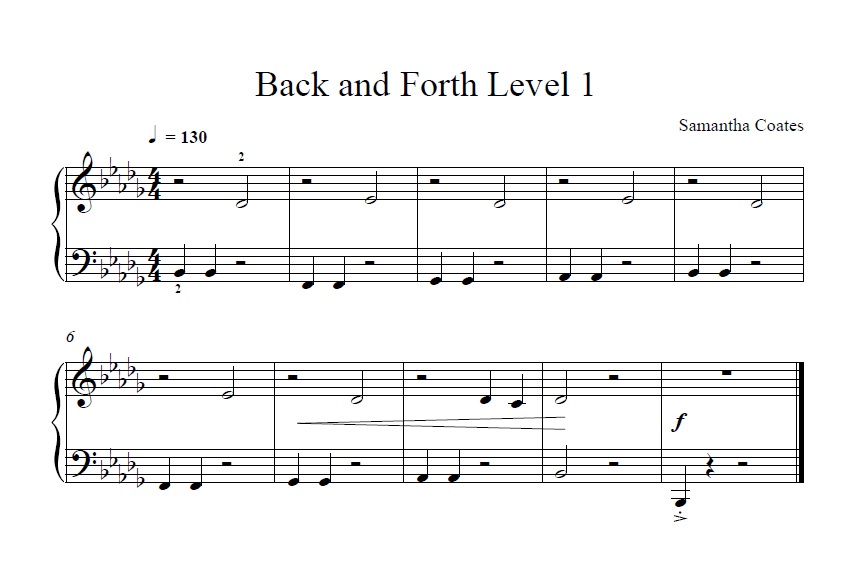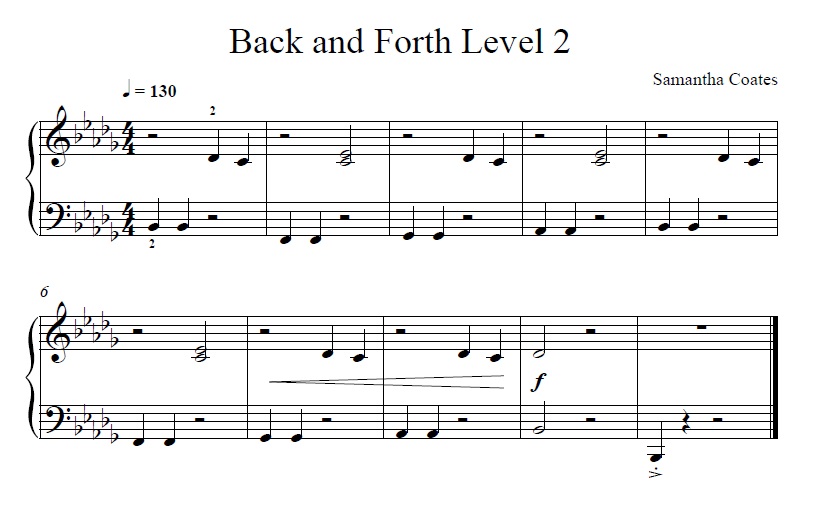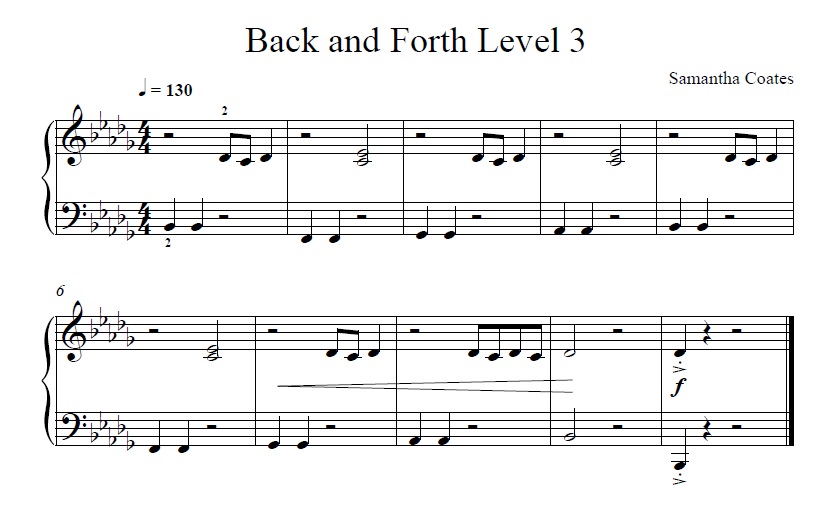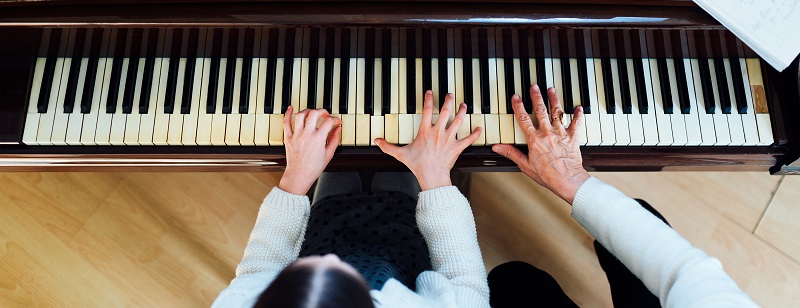an interview with Samantha Coates about the conceptualisation of her new Rote Repertoire series.
Were you ever taught by rote as a student?
Yes, by my grandmother. She taught me that piece I call ‘The Black Note Thing’ but which is apparently officially named ‘Shave and a Haircut’! However, my rote experience stopped the minute I started piano lessons, aged 5, with my strict Russian teacher. My tuition from then on was purely notation based.
When was the first time you came across rote teaching?
I inherited a gorgeous student named Simone, about 15 years ago. She was 11 years old and had previously been with a Suzuki teacher for 5 years. She played Burgmuller’s Progress very nicely, but she could not read a single note of music and had poor aural skills. At that time, I didn’t really understand how rote teaching worked (and proper Suzuki teaching is actually done by ear, not by rote, so she had been badly taught all round) and I didn’t know how to capitalise on her playing skills. Unfortunately for her, I took her right back to the beginning. I wouldn’t do that now!
Do you ever teach by rote?
Until the last year, no. I was brought up to believe that rote was bad! But if I had Simone now, I would continue to teach her by rote whilst simultaneously developing her reading skills through other pieces. My new Rote Repertoire series is written with students like her in mind! I also use a combination of rote and reading with most students, because it aids their reading.
Why did you decide to compose rote pieces?
It all started in 2017 at the MTNA conference in Baltimore, where I attended a fabulous session by Piano Safari authors and creators Dr Julie Knerr and Katherine Fisher. As I sat listening to them list all the reasons why rote teaching is so good when combined with reading, I started to think about my 15-year old student Josiah and how he was struggling with piano.
Josiah enjoyed playing piano but hated reading. I, of course, wouldn’t let him bypass the reading and made sure he understood every single element on the page prior to playing it. He did not enjoy practising and whilst he was a very capable pianist once he got going, learning pieces was always a slow and laborious process.
I thought to myself, ‘I am going to put Josiah out of his misery.’
I started teaching Josiah by rote for some parts of his pieces. This kind of went against my grain, but boy oh boy, did his progress go through the roof! Then I started writing pieces for him that were entirely based on patterns, to develop his reading. I used complex-to-look-at-but-easy-to-play rhythms and keys. I taught a simplified version of the piece to him by rote, and THEN got him to recognise the patterns in the more complex version. This WORKED!
What is it that takes students ‘beyond’ rote to reading?
The ‘beyond’ is composition and improvisation. Once they have learned Levels 1-3, I ask students to go home and compose their own ‘Level 4’. The way the Levels are presented gives them a basis for easily creating their own versions. All of my students love doing this, and this is the true essence of music!
Why are your pieces written in three levels?
The pieces I wrote for Josiah were designed specifically to get him reading. Level 3 is the actual piece, whilst Levels 1 and 2 are simplified versions. All three levels are important for every student; the point of this series is to develop sight reading skills through repertoire, so it is the process of getting from Level 1 to Level 3 that is important.
Can you give us an example?
Sure! Here is a piece called Back and Forth. It is in a contemporary ‘rock’ style, which appeals to slightly older beginners. As you can see, it is in a comfortable B-flat minor hand position, with longer fingers on black notes and thumb and 5th finger on white notes (all of the pieces are written in accordance with Taubman principles of piano technique).
Level 1 needs to be taught by rote, because we would never expect students to read in this key in the early stages! Model/demonstrate two bars at a time, explaining that the RH goes back and forth between D♭ and E♭. It’s a good idea for students to be listening to the audio file between lessons, so that they get used to incorporating the dynamics – plus there are Level 1 reminder videos on the BlitzBooks Rote Repertoire YouTube channel.
Once the student can play Level 1 well, show them the score and say ‘this is what you just played!’. Encourage them to play again with the score, if possible.

Show the student Level 2 and before they play anything, ask them to ‘spot the difference’ between the Level 1 and Level 2 scores. There is a slight variation in rhythm, and now the RH is playing more Cs, including a 2-note chord. Ask them how they think this will sound and try out the different parts, then play the whole piece.

Once Level 2 is fluent, show them the score for Level 3 and once again ‘spot the difference’, scanning thought the music before playing. They should notice that the LH remains the same but the RH has a rhythmic variation. Students could clap this before playing.
Once they’ve mastered all three levels… ask them to make up their own Level 4!

Who are the pieces for?
Everyone. Quite literally. From beginners to advanced. Beginners will have these as their repertoire pieces and composition activities. Intermediate and advanced will use these as sight reading and creativity exercises. These pieces are also excellent for pianists recovering from injury, because they are all written in comfortable hand positions that encourage a healthy technique. I was inspired to do this after I had tendonitis myself, and got help from Taubman specialists.
How did you get the idea for the Rote Repertoire website?
It seemed the only sensible way to get the pieces out there together with the support material. Having pieces available digitally meant that I could include videos, audio tracks and teacher guides. I also like the idea of having a website with the word ‘rote’ in it – to get people used to the idea that rote teaching can be awesome!
How can teachers and students access your new series?
Go to www.roterepertoire.com. The pieces are all displayed in a colourful format and there are lots of instructional videos on the site. Each piece comes in a ‘pack’ that contains sheet music, video teaching tutorials, a teacher guide and audio tracks. Pieces can be bought as individual packs, in repertoire bundles, or as part of a membership (see the end of this article for a special offer!).
Will there be a Rote Repertoire book?
Yes – it will be launched in January! I’m going to be doing a workshop tour with Brenda Hunting; she will discuss the pieces from the point of view of developing a healthy piano technique. The book will be great for students and teachers who prefer books over printouts. However, book form has its limitations: it’s a single license (as opposed to the digital versions, which are studio-licensed) and it doesn’t come with any of the video or audio support material. However, students can always access the YouTube channel!
This looks like a lot of work! Are you still writing theory and sight reading books?
Yes, of course! I am still revising and updating the rest of the series all the time. My passion is music literacy, and that’s what BlitzBooks is all about — it started with theory, then sight reading, and now more reading through repertoire.
What do you hope students will gain from your series?
So many things! Music literacy — the ability to scan music and read fluently; a love of composing and creating; and a healthy piano technique. My hope is that with this series, students can have it all: contemporary pieces that sound interesting, sight reading skills, a solid technique AND improvisation and composition opportunities… all with the goal of fostering a lifelong love of music.
